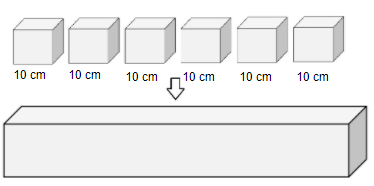
If six cubes, each of 10 cm edge, are joined end to end, then find the surface area of the resulting solid (in $c{{m}^{2}}$).
Answer
563.1k+ views
Hint: We need to find the speciality of the resulting figure after joining the six cubes. Using the help of image, we find out the figure and its dimensions. Then we will use the formula, $A=2\left( lb+bh+hl \right)c{{m}^{2}}$ to find out the surface area of the figure.
Complete step by step answer:
Six cubes each of 10 cm edge are joined end to end. With the help of a figure we will find out the changes in the dimensions of the cubes before and after the joining.

So, we can see that when we are adding the six cubes end to end the only dimension of length is changing its value. The dimension of breadth and height is intact.
After the joining of six cubes the total figure changed into a cuboidal.
The length of the cuboidal is equal to the sum of the lengths of the six cubes.
The length of a single cube is 10 cm. So, the length of the cuboidal will be $10\times 6=60$ cm.
The breadth and the height of the cuboidal is equal to the breadth and the height of a single cube.
The breadth and the height of a single cube is 10 cm. So, the breadth and the height of the cuboidal will be 10 cm.
So, we got a cuboidal with its dimension being length (l)= 60, breadth (b)= 10, height (h)= 10 cm. We need to find the surface area.
The formula for surface area is $A=2\left( lb+bh+hl \right)c{{m}^{2}}$.
We put the values of the cuboidal to find the solution as
$A=2\left( 60\times 10+60\times 10+10\times 10 \right)=2\times 1300=2600c{{m}^{2}}$
So, the surface area of the resulting cuboidal is 2600 $c{{m}^{2}}$.
Note: We need to be careful about choosing a dimension being changed. It not necessarily has to be the length which got changed. The important thing is only one dimension out of three will be changed. It can be breadth or height also.
Complete step by step answer:
Six cubes each of 10 cm edge are joined end to end. With the help of a figure we will find out the changes in the dimensions of the cubes before and after the joining.

So, we can see that when we are adding the six cubes end to end the only dimension of length is changing its value. The dimension of breadth and height is intact.
After the joining of six cubes the total figure changed into a cuboidal.
The length of the cuboidal is equal to the sum of the lengths of the six cubes.
The length of a single cube is 10 cm. So, the length of the cuboidal will be $10\times 6=60$ cm.
The breadth and the height of the cuboidal is equal to the breadth and the height of a single cube.
The breadth and the height of a single cube is 10 cm. So, the breadth and the height of the cuboidal will be 10 cm.
So, we got a cuboidal with its dimension being length (l)= 60, breadth (b)= 10, height (h)= 10 cm. We need to find the surface area.
The formula for surface area is $A=2\left( lb+bh+hl \right)c{{m}^{2}}$.
We put the values of the cuboidal to find the solution as
$A=2\left( 60\times 10+60\times 10+10\times 10 \right)=2\times 1300=2600c{{m}^{2}}$
So, the surface area of the resulting cuboidal is 2600 $c{{m}^{2}}$.
Note: We need to be careful about choosing a dimension being changed. It not necessarily has to be the length which got changed. The important thing is only one dimension out of three will be changed. It can be breadth or height also.
Recently Updated Pages
Two men on either side of the cliff 90m height observe class 10 maths CBSE

What happens to glucose which enters nephron along class 10 biology CBSE

Cutting of the Chinese melon means A The business and class 10 social science CBSE

Write a dialogue with at least ten utterances between class 10 english CBSE

Show an aquatic food chain using the following organisms class 10 biology CBSE

A circle is inscribed in an equilateral triangle and class 10 maths CBSE

Trending doubts
Why is there a time difference of about 5 hours between class 10 social science CBSE

Write a letter to the principal requesting him to grant class 10 english CBSE

What is the median of the first 10 natural numbers class 10 maths CBSE

The Equation xxx + 2 is Satisfied when x is Equal to Class 10 Maths

Which of the following does not have a fundamental class 10 physics CBSE

State and prove converse of BPT Basic Proportionality class 10 maths CBSE




